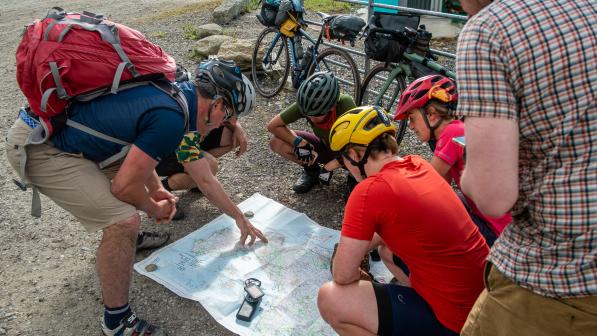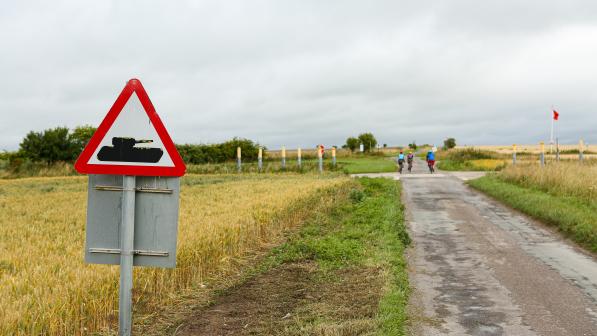Where in England and Wales can I ride off road?

In England and Wales we have a network of routes and trails available to cyclists to get you out into the countryside – but it isn’t always obvious where you can and where you can’t ride. Here we clarify where you can legally cycle off road.
Where can I ride?
In England and Wales, cyclists have a legal right to ride on some public paths, but not others (see below).
There is a variety of other off-road access opportunities, such as disused railway tracks (often highlighted as part of the National Cycle Network), country parks and canal towpaths, most of which are ideal for beginners and family-friendly cycling. Many (but not all) of these routes are shown on Ordnance Survey maps.
There are also a number of promoted mountain biking trails. Organisations such as Forestry England and Natural Resources Wales have developed specialist mountain bike trail centres with a range of trails with something suitable for all abilities.
These are graded from easy ‘green’ trails through to more extreme ‘black’ trails, which should only be undertaken by experienced off-road riders.
Access legislation is currently being reviewed in Wales. This guide represents the current position and will be updated to reflect any changes.
Wherever you choose to ride – ride responsibly, follow the Countryside Code for England or Wales, and above all, enjoy yourself!

Public rights of way: the short version
Public access is quite a complex issue, so we’ll give a brief explanation first, followed by a more detailed one.
There are several different types of public path, which have different legal status. They are marked by different symbols and colours on maps and signposts.
You have a right to ride a horse or a bike on any bridleway, restricted byway or byway open to all traffic. You can also ride a bike on any cycle track, and on routes shown on an Ordnance Survey map as ‘other route with public access’.

Footpath
A recorded right of way on foot (see extra details section below).
Bridleway
A recorded right of way on foot, on horseback and/or leading a horse, and on a bicycle (introduced by the Countryside Act 1968 after intervention by CTC/Cycling UK). Cyclists must give way to walkers and horse riders if encountered.
Restricted byway
A recorded right of way on foot, horseback and/or leading a horse, on a bike, or on any other non-mechanically propelled vehicle (such as a pony and trap).
Byway open to all traffic (BOAT)
A recorded right of way on foot, horseback and/or leading a horse, on a bike, or with any other vehicle including cars and motorbikes.
Other routes
Cycle tracks
Technically not normally discussed as a ‘public right of way’ as they are not featured on the ‘definitive map’ held by local authorities, but a type of highway over which the public has a right of way on pedal cycles, with or without a right of way on foot.
Unsealed Unclassified Roads (shown on OS maps as ‘other route of public access’)
Sometimes also referred to as ‘green lanes’ or ‘white roads’. Once again, technically not a ‘public right of way’, but rights of access on these routes are generally the same as on byways open to all traffic.
Permissive paths
Permissive paths are where the landowner has given written permission for a route to be used across their land; they are not public rights of way. Landowners have the power to redirect or even close the path. Landowners may dedicate a permissive path to walkers only, cyclists only, horses/riders only, or all three groups.
Permissive paths are often found on Local Authority/Railway Authority or National Trust land, and also include many Sustrans routes on the National Cycle Network.
Towpaths
Most canals in England and Wales are looked after by the Canal and River Trust, which allows cycling across its network (other than a few short ‘no cycling’ sections where it is very narrow or there are a lot of locks). Canals have a laid-back air so expect to move at a leisurely pace, and follow the towpath code.
Navigable rivers (such as the Trent, Severn and Thames) are a different situation as the towpaths are owned by the landowner adjacent to the river, and often don’t have cycling access.
Access land
Generally there is no right of access using a bicycle on access land, although in places permissive or de facto access rights may exist. Legislation on this issue is currently under review in Wales.

Public rights of way: the extra details
Recorded rights
We have been careful to include here the word ‘recorded’. The recorded legal status of a right of way may not always reflect existing higher rights. For example, a route may be recorded as a footpath but have historically been used as a cart road, so rights for carriage driving, horse riding and cycling may still exist.
Some historic rights of way do not appear on the map at all. These higher rights can be proven by researching historic maps and applying for a Definitive Map Modification Order.
Higher rights may also exist where established use by the public over a period of time has given cause for a change in status. You can find more information about this in our guide to developing new paths for cycling in the countryside. This can be a complex area of law and we would suggest getting advice before relying on this to justify use.
A right of reasonable use
A right of way includes not only the right to pass and repass, but also includes any reasonable use that does not interfere with the primary right of passage. The definition of this is decided on a case-by-case basis.
The courts have in the past found that such uses as photography and picnics, and even protests, may be permissible as ‘reasonable’, but it depends on the nature of the right of way and the level of intrusion caused.
Cycling UK, and, indeed, Parliament, believe that this is almost certain to extend to wheeling a bicycle, and there are arguments that in some cases it could even extend to camping overnight by the side of a highway as long as it did not prevent use by others.
Is cycling on a footpath illegal?
No – it is classed as a trespass against the landowner, which is normally a civil offence rather than a criminal one. This means that the landowner can sue the trespasser for damages in the civil courts, but the police are not involved and there’s no criminal record for the offender.
However, in some places byelaws might apply, in which case the situation is different, and use would be a criminal offence (albeit very minor), although we’re yet to meet anyone who has been convicted of such.
The confusion often comes from Section 72 of the 1835 Highway Act, which makes it an offence to ride on “any footpath or causeway by the side of any road,” meaning a footway or pavement, rather than a public footpath.
It is an offence to cycle on any highway (including public rights of way) in a reckless or careless manner, or without due care and consideration for other users.
Cycling UK is campaigning for wider use of the footpath network for cycling (not to be interpreted as saying that all footpaths should be open for cycling), as the current system reflects only historic recorded use rather than suitability for use – many footpaths are better suited for cycling than nearby bridleways.
What about e-cycles, trikes and adapted cycles?
E-bikes which comply with regulations are categorised as a bicycle, so can be used, by a person aged over 14, on bridleways, restricted byways, cycle tracks and other routes.
Technically, the right to cycle on bridleways only applies to bicycles, not tricycles. As a non-mechanically propelled vehicle, tricycles can be used on restricted byways, byways open to all traffic and cycle tracks. However, if the tricycle is an adapted cycle for disabled use, it can be used more widely.
Cycles that have been constructed or adapted for use by a physically disabled rider can be used in the same way as wheelchairs and mobility vehicles, anywhere where a right of access ‘on foot’ applies (under Section 20 of the Chronically Sick and Disabled Persons Act 1970).






























